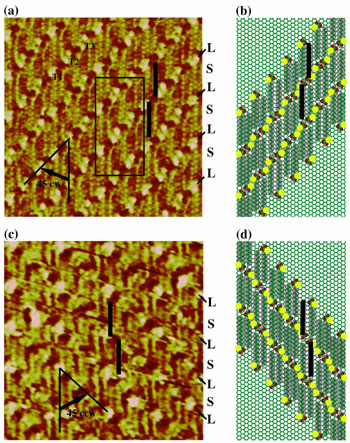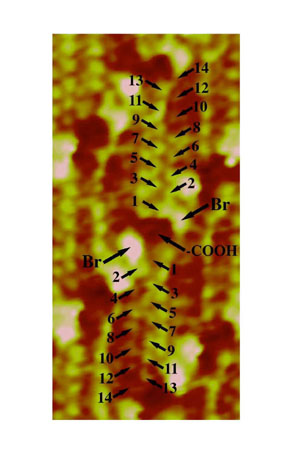
Left (a) 12 X 12 nm2 STM constant-current image of (R)-2-bromohexadecanoic acid at the interface of a phenyloctane solution and the graphite basal plane. One molecular length is indicated by a thick black bar. Two thick balck bars correspond to the chiral dimer formed by two molecules hydrogen-bonded through carboxyl groups. The 45° angle "clockwise" is from the direction of the long axis of the molecule to to the direction of the lamellar orientation. Capital letter L points to lines with alternating bright and dark segments, and S refers to the strips of small spots between the lines. The imaging parameters are 1.4 V (sample negative) and 300 pA. (b) Top view of a model of (R)-2-bromohexadecanoic acid molecules on a graphite surface. Yellow represents bromine atoms, green represents carbon atoms, gray represents hydrogen atoms, and red represents oxygen atoms. Two black bars mark the chiral dimer formed by two molecules hydrogen-bonded through the carboxyl groups. (c) 12 X 12 nm2 STM image of (S)-2-bromohexadecanoic acid at the interface of a phenyloctane solution and the graphite basal plane. One molecular length is indicated by a thick black bar. Two black bars correspond to the chiral dimer formed by two molecules hydrogen-bonded through carboxyl groups. The 45° angle "counterclockwise" is from is from the direction of the long axis of the molecule to the direction of the lamellar orientation. Capital letter L points to lines with alternate bright and dark segments, and S refers to the strips of small spots between the lines. the imaging parameters are 1.4 V (sample negative) and 300 pA. (d) Top view of a model of (S)-2-bromohexadecanoic acid molecules on a graphite surface. Two black bars mark the chiral dimer formed by two molecules hydrogen-bonded through carboxyl groups.
For more detail, see: Fang, H.; Giancarlo, L.C.; Flynn, G.W.; J. Phys. Chem. B 1998, 102, 7311-7315.
